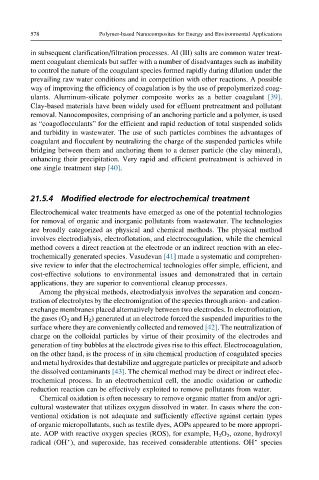Page 626 - Polymer-based Nanocomposites for Energy and Environmental Applications
P. 626
578 Polymer-based Nanocomposites for Energy and Environmental Applications
in subsequent clarification/filtration processes. Al (III) salts are common water treat-
ment coagulant chemicals but suffer with a number of disadvantages such as inability
to control the nature of the coagulant species formed rapidly during dilution under the
prevailing raw water conditions and in competition with other reactions. A possible
way of improving the efficiency of coagulation is by the use of prepolymerized coag-
ulants. Aluminum-silicate polymer composite works as a better coagulant [39].
Clay-based materials have been widely used for effluent pretreatment and pollutant
removal. Nanocomposites, comprising of an anchoring particle and a polymer, is used
as “coagoflocculants” for the efficient and rapid reduction of total suspended solids
and turbidity in wastewater. The use of such particles combines the advantages of
coagulant and flocculent by neutralizing the charge of the suspended particles while
bridging between them and anchoring them to a denser particle (the clay mineral),
enhancing their precipitation. Very rapid and efficient pretreatment is achieved in
one single treatment step [40].
21.5.4 Modified electrode for electrochemical treatment
Electrochemical water treatments have emerged as one of the potential technologies
for removal of organic and inorganic pollutants from wastewater. The technologies
are broadly categorized as physical and chemical methods. The physical method
involves electrodialysis, electroflotation, and electrocoagulation, while the chemical
method covers a direct reaction at the electrode or an indirect reaction with an elec-
trochemically generated species. Vasudevan [41] made a systematic and comprehen-
sive review to infer that the electrochemical technologies offer simple, efficient, and
cost-effective solutions to environmental issues and demonstrated that in certain
applications, they are superior to conventional cleanup processes.
Among the physical methods, electrodialysis involves the separation and concen-
tration of electrolytes by the electromigration of the species through anion- and cation-
exchange membranes placed alternatively between two electrodes. In electroflotation,
the gases (O 2 and H 2 ) generated at an electrode forced the suspended impurities to the
surface where they are conveniently collected and removed [42]. The neutralization of
charge on the colloidal particles by virtue of their proximity of the electrodes and
generation of tiny bubbles at the electrode gives rise to this effect. Electrocoagulation,
on the other hand, is the process of in situ chemical production of coagulated species
and metal hydroxides that destabilize and aggregate particles or precipitate and adsorb
the dissolved contaminants [43]. The chemical method may be direct or indirect elec-
trochemical process. In an electrochemical cell, the anodic oxidation or cathodic
reduction reaction can be effectively exploited to remove pollutants from water.
Chemical oxidation is often necessary to remove organic matter from and/or agri-
cultural wastewater that utilizes oxygen dissolved in water. In cases where the con-
ventional oxidation is not adequate and sufficiently effective against certain types
of organic micropollutants, such as textile dyes, AOPs appeared to be more appropri-
ate. AOP with reactive oxygen species (ROS), for example, H 2 O 2 , ozone, hydroxyl
radical (OH ), and superoxide, has received considerable attentions. OH species
%
%

